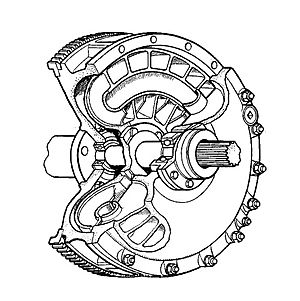Fluid coupling facts for kids
A fluid coupling, also called a hydraulic coupling or fluid flywheel, is a special device that helps send power from one spinning machine part to another. Think of it like a smooth way to connect an engine to the wheels of a car.
In cars, fluid couplings have been used in the transmission system. They offer a smooth way to start moving, unlike a regular mechanical clutch which can sometimes feel jerky. While a fluid coupling is simpler than a torque converter, it doesn't make the engine's power stronger (it doesn't multiply torque). Because of this, it always needs to work together with a gearbox to help the car change speeds.
Contents
What is a Fluid Coupling?
A fluid coupling is a mechanical device that uses fluid, usually oil, to transfer rotating power. Imagine two fans facing each other. If you turn on one fan, the air it blows will make the other fan spin too. A fluid coupling works in a similar way, but instead of air, it uses a special oil to transfer the power.
How Does a Fluid Coupling Work?
A fluid coupling has two main parts inside a sealed casing filled with oil:
- Pump (or Impeller): This part is connected to the engine or the power source. When the engine spins, it makes the pump spin. The pump has blades that push the oil outwards.
- Turbine (or Runner): This part is connected to the machine that needs to receive the power, like the car's transmission. The turbine also has blades.
When the pump spins, it throws the oil against the blades of the turbine. This force of the moving oil makes the turbine start to spin, transferring the power smoothly from the engine to the transmission.
Smooth Power Transfer
One of the best things about a fluid coupling is how smoothly it transfers power. When a car starts, the engine can spin without immediately forcing the wheels to turn. This allows for a very gentle start, preventing the engine from stalling. It also helps to absorb any sudden shocks or vibrations that might come from the engine, making the ride smoother.
Fluid Couplings in Cars
Fluid couplings were popular in cars, especially before the 1950s, as an alternative to the traditional mechanical clutch.
Why Cars Used Fluid Couplings
- Smooth Starts: They allowed drivers to start moving very smoothly, without the jerking motion that can sometimes happen with a mechanical clutch.
- No Stalling: The engine could keep running even when the car was stopped (like at a traffic light) because the fluid coupling allowed some "slip" between the engine and the wheels. This meant the engine wouldn't stall.
- Less Wear: Unlike a mechanical clutch that uses friction plates that wear out over time, a fluid coupling uses oil, so there's less wear and tear on parts.
Fluid Coupling vs. Torque Converter
While fluid couplings are simple and smooth, they have a limitation: they don't multiply torque. This means they can't make the engine's power feel stronger at low speeds, which is very helpful for getting a heavy car moving. This is where a torque converter is different. A torque converter is like an improved fluid coupling that can multiply torque, making it more efficient for modern automatic transmissions. Because of this, torque converters largely replaced fluid couplings in cars.
Other Uses of Fluid Couplings
Fluid couplings aren't just for cars! They are also used in many other types of machinery where smooth power transfer and protection from shocks are important.
Industrial Applications
- Conveyor Belts: They help conveyor belts start smoothly, preventing sudden jerks that could damage the belt or the items on it.
- Pumps and Fans: They can be used to control the speed of large pumps and fans, saving energy and reducing stress on the motors.
- Marine Propulsion: In some boats and ships, fluid couplings help connect the engine to the propeller, providing a smooth and reliable way to transfer power.
Images for kids
See also
 In Spanish: Acoplador hidráulico para niños
In Spanish: Acoplador hidráulico para niños



